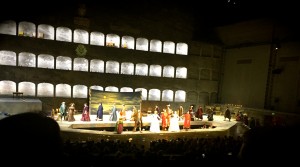In a time when opera is trying to reinvent itself and competing with all number of entertainment that has to do much less work to seem relevant, Mozart’s Cosi Fan Tutte at this year’s Salzburger Festspiele is a remarkably original balance of the old looking forward to the new.
This balance begins with supernumeraries who are already on stage as audience members find their seats. Enlightenment-era scientists, wearing long white masks and velvet robes, mull over two sketches of human anatomy—one female, one male. Pulling on long beards, frowning at the ovaries, these perplexed philosophers show that the scenes to come are already but a mise-en-abyme. Their antiquated science is quickly framed and replaced by our own rationalization of the romantic comedy before us. After all, who can make sense of love?
Conductor Ottavio Dantone makes his Salzburg Fest debut with this opera and controls the work with precise tempos both fast and slow. As he began the overture, a curious Dorabella and Fiordiligi scurry to stage left where the scientists have retired at individual laboratory tables, laughing and pointing at the diagrams. But the scientists follow the unsuspecting women back to center stage, seize them, and cover their mouths with a handkerchief of chloroform. The men position the unconscious women on a settee, who later awake as if in a dream, and Mozart’s comedy becomes a scientific experiment of Enlightenment proportions.
The program notes that director Sven-Eric Bechtolf wanted to capture this opera in the year 1790, when it originally debuted, as a moment of (violent) transition from scientific logic to the romantic chaos that the French Revolution engendered. What he’s done here with the stagecraft—from blocking to set to costumes—is a clever symmetry throughout. The two pairs-—Fernando and Guglielmo, Dorabella and Fiordiligi dressed in period costumes—organize so neatly across the stage, crossing paths and then re-organizing, that the identity confusion inherent to the plot is heightened to a satiric degree. Even while the plot tests the essence of opposite genders, it also makes this stark difference paradoxically homogenous.
The talent across the board makes it possible to raise this special peculiarity of time and space where historic attention meets innovation. German soprano Julia Kleiter, as Fiordiligi, floats and soars with transporting grace (she was undoubtedly the audience favorite at the curtain call). As Dorabella, Angela Brower fulfills the more changeable sister’s character with a sweet and accurate clarity while still performing as an amusing flirt. Alessio Arduini (Guglielmo), the experienced Martina Jankova (Despina), and the puppet master Michael Volle (Don Alfonso) all perform with the ease of true professionals. The standout is Mauro Peter in the role of Ferrando, who delivered a quintessential “Un ‘aura amorosa” with a thrillingly round timbre for a tenor. It’s singers like these that make you forget you are watching an opera and allow you to be simply consumed by it.
Naturally, the setting of the Festspielhaus in Salzburg, half cliff-half theatre, reminds one of the ancient, not to the mention the fact that Mozart’s birth house is a street away. How difficult it must be, then, to maintain ties to the opera’s roots while delivering something that feels as new and exciting as Corigliano’s Ghosts of Versaille.
The trick is in the details. When the opera proper begins, for example, the scientists unroll and set up idyllic watercolor backdrops around the six characters and then appear a level or two up between the cloisters built into the cliff. As they look down on the singers playing out their gendered experiment, emotion takes the lead. When Ferrando realizes he is betrayed, he stabs a watermelon brought out for refreshment and breaks into it with his hands, pulling finger-fulls up into the air and squeezing juice onto the rug below. Next he moves over to a pillow, which he also stabs and hurls the stuffing across stage left. The metaphor is not subtle, and while it is at one moment making light of the changeability of women, the next it borders on a darker aggression that many iterations of Cosi don’t even come close to.
If you paid your 10 Euros for the program, you’ll also get a list of the Cosi’s the festival has performed. Since 1922, the festival has produced the opera 44 times. The statistics makes this production even more impressive, if that were possible. This is Mozart opera at its absolute best, delightful and timelessly provoking, because it finds us racing to logic even as it presses on those human conundrums that find no refuge in rationality.


Wish I had been there.